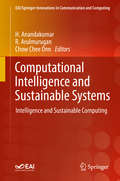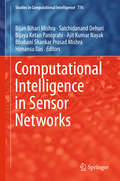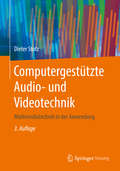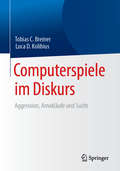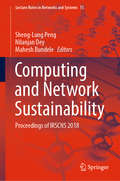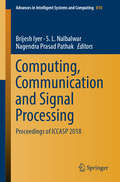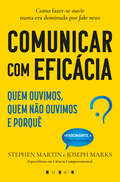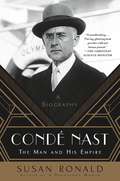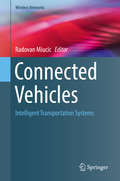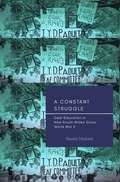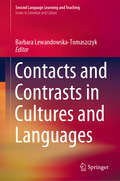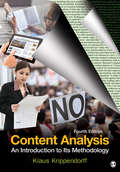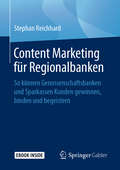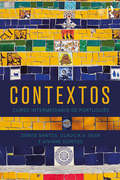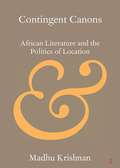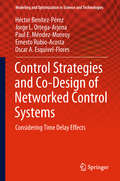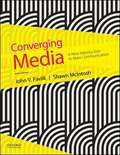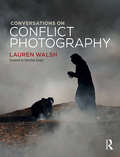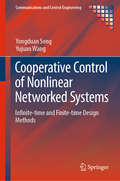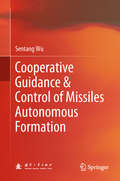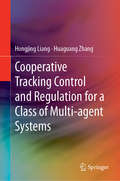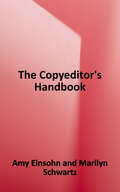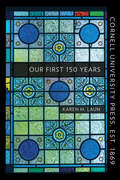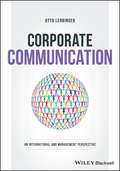- Table View
- List View
Computational Intelligence and Sustainable Systems: Intelligence and Sustainable Computing (EAI/Springer Innovations in Communication and Computing)
by H. Anandakumar R. Arulmurugan Chow Chee OnnThis book features research related to computational intelligence and energy and thermal aware management of computing resources. The authors publish original and timely research in current areas of power, energy, temperature, and environmental engineering as and advances in computational intelligence that are benefiting the fields. Topics include signal processing architectures, algorithms, and applications; biomedical informatics and computation; artificial intelligence and machine learning; green technologies in information; and more. The book includes contributions from a wide range of researchers, academicians, and industry professionals. The book is made up both of extended papers presented at the International Conference on Intelligent Computing and Sustainable System (ICICSS 2018), September 20-21, 2018, and other accepted papers on R&D and original research work related to the practice and theory of technologies to enable and support Intelligent Computing applications.
Computational Intelligence in Sensor Networks (Studies in Computational Intelligence #776)
by Himansu Das Bhabani Shankar Prasad Mishra Ajit Kumar Nayak Bijaya Ketan Panigrahi Satchidanand Dehuri Bijan Bihari MishraThis book discusses applications of computational intelligence in sensor networks. Consisting of twenty chapters, it addresses topics ranging from small-scale data processing to big data processing realized through sensor nodes with the help of computational approaches. Advances in sensor technology and computer networks have enabled sensor networks to evolve from small systems of large sensors to large nets of miniature sensors, from wired communications to wireless communications, and from static to dynamic network topology. In spite of these technological advances, sensor networks still face the challenges of communicating and processing large amounts of imprecise and partial data in resource-constrained environments. Further, optimal deployment of sensors in an environment is also seen as an intractable problem. On the other hand, computational intelligence techniques like neural networks, evolutionary computation, swarm intelligence, and fuzzy systems are gaining popularity in solving intractable problems in various disciplines including sensor networks. The contributions combine the best attributes of these two distinct fields, offering readers a comprehensive overview of the emerging research areas and presenting first-hand experience of a variety of computational intelligence approaches in sensor networks.
Computergestützte Audio- und Videotechnik: Multimediatechnik in der Anwendung
by Dieter StotzDiese Einführung in die moderne Audio- und Videotechnik ermöglicht Lesern mit technischem Grundverständnis einen leichten Einstieg – auch in komplexe Zusammenhänge. Der Autor vermittelt detailliertes Wissen, praxisnah und verständlich aufbereitet: von den Grundlagen der Ton- und Videotechnik über Abtastung und Digitalisierung, räumliches Hören, Datenkompression, MIDI-Standard und -Signale, digitale Audiomesstechnik bis zu hochauflösender Videotechnik, Genlock, Chromakeying, Schnittsystemen und Animation. Mit vielen Graphiken und Abbildungen.
Computerspiele im Diskurs: Aggression, Amokläufe und Sucht
by Tobias C. Breiner Luca D. KolibiusDieses Fachbuch ist eine umfassende Abhandlung zur Debatte um die negativen Auswirkungen von Computerspielen: Aggressionen, Amokläufe und Sucht. Die kontroverse Debatte zur Beziehung zwischen Computerspielen und Aggression wird hier auf Grundlage neuster wissenschaftlicher Erkenntnisse aufgearbeitet. Darüber hinaus inspirierte die Aufnahme in die aktuellste Version des Klassifikationssystems DSM für Internet Gaming Disorder (Computerspielsucht) eine Vielzahl wissenschaftlicher Veröffentlichungen, welche hier übersichtlich zusammengetragen werden. In diesem Buch finden Sie die Antworten auf folgende Fragen: Welche Symptome machen eine Computerspielabhängigkeit aus und welche Therapiemöglichkeiten gibt es?Geht Computerspielsucht mit Veränderungen im Gehirn und der Persönlichkeit einher?Gibt es eine kausale Beziehung zwischen Computerspielen einerseits und Aggressivität und Amokläufen andererseits? Die Autoren kommen dabei nach Sichtung der Studienlage zu überraschenden Erkenntnissen. Dieses Buch unterstützt Psychologen, Psychotherapeuten, Psychiater, Pädagogen, Therapeuten, Lehrkräfte und Eltern die Welt der Computerspiele zu navigieren.
Computing and Network Sustainability: Proceedings of IRSCNS 2018 (Lecture Notes in Networks and Systems #75)
by Nilanjan Dey Sheng-Lung Peng Mahesh BundeleThis book offers a compilation of technical papers presented at the International Research Symposium on Computing and Network Sustainability (IRSCNS 2018) held in Goa, India on 30–31st August 2018. It covers areas such as sustainable computing and security, sustainable systems and technologies, sustainable methodologies and applications, sustainable networks applications and solutions, user-centered services and systems and mobile data management. Presenting novel and recent technologies, it is a valuable resource for researchers and industry professionals alike.
Computing, Communication and Signal Processing: Proceedings Of Iccasp 2018 (Advances In Intelligent Systems and Computing #810)
by Nagendra Prasad Pathak S. L. Nalbalwar Brijesh IyerThis book highlights cutting-edge research on various aspects of human–computer interaction (HCI). It includes selected research papers presented at the Third International Conference on Computing, Communication and Signal Processing (ICCASP 2018), organized by Dr. Babasaheb Ambedkar Technological University in Lonere-Raigad, India on January 26–27, 2018. It covers pioneering topics in the field of computer, electrical, and electronics engineering, e.g. signal and image processing, RF and microwave engineering, and emerging technologies such as IoT, cloud computing, HCI, and green computing. As such, the book offers a valuable guide for all scientists, engineers and research students in the areas of engineering and technology.
Comunicar com Eficácia: Quem Ouvimos, Quem Não Ouvimos e Porquê
by Stephen Martin Joseph MarksCOMO CONQUISTAR CONFIANÇA, SABER TRANSMITIR MENSAGENS E INFLUENCIAR PESSOAS Vivemos num mundo em que factos comprovados e dados verificáveis estão amplamente disponíveis. Porque será, então, que as pessoas escolhem dar ouvidos a ignorantes em vez de prestar atenção a especialistas confiáveis? E por que motivo pormenores aparentemente irrelevantes, como a aparência física ou o estatuto socioeconómico, influenciam se iremos ou não confiar no que uma pessoa diz, independentemente da fiabilidade dos seus conhecimentos? Neste livro inovador, os especialistas em ciência comportamental Stephen Martin e Joseph Marks revelam as forças que atuam por detrás de alguns dos fenómenos mais irritantes e nocivos da atualidade, como a crença em fake news ou a conquista de cargos políticos por parte de pessoas que veiculam informações erradas e mentem de forma descarada. Explicam também de que forma o mensageiro, ao deter ou ao adquirir determinados traços, como os que definem uma pessoa carismática, se pode tornar mais importante do que a mensagem veiculada, influenciando negócios, políticas, comunidades e a nossa sociedade em geral. «Comunicar com Eficácia é um verdadeiro tour de force que aborda um assunto crucial de forma oportuna e fortemente fundamentada em pesquisas. Não consigo pensar em nenhum outro livro capaz de tratar de modo tão convincente os papéis e os atributos do mensageiro moderno.» Robert Cialdini, autor bestseller de Pré-Suasão «Compreender em quem confiamos e porquê é fundamental para explicar tudo, desde a liderança ao poder, e até mesmo os nossos relacionamentos diários. Esclarecedor e interessante, este livro ajuda-nos a entender aqueles que seguimos e por que motivo o fazemos, seja na política, nos negócios ou na vida quotidiana.» Sinan Aral, professor de Gestão no MIT «A utilidade deste livro reside no facto de ter sido concebido para auxiliar consumidores e cidadãos a entenderem quando estão a ser manipulados e a tomarem medidas para resistir a isso.» Harvard Business Review «Um livro que demonstra como a nossa consideração inata por fatores como a beleza ou o estatuto, em detrimento de evidências e factos comprovados, torna pouco surpreendente que vivamos num mundo inundado de fake news.» Financial Times
Condé Nast: The Man and His Empire -- A Biography
by Susan RonaldThe first biography in over thirty years of Condé Nast, the pioneering publisher of Vogue and Vanity Fair and main rival to media magnate William Randolph Hearst. Condé Nast’s life and career was as high profile and glamorous as his magazines. Moving to New York in the early twentieth century with just the shirt on his back, he soon became the highest paid executive in the United States, acquiring Vogue in 1909 and Vanity Fair in 1913. Alongside his editors, Edna Woolman Chase at Vogue and Frank Crowninshield at Vanity Fair, he built the first-ever international magazine empire, introducing European modern art, style, and fashions to an American audience. Credited with creating the “café society,” Nast became a permanent fixture on the international fashion scene and a major figure in New York society. His superbly appointed apartment at 1040 Park Avenue, decorated by the legendary Elsie de Wolfe, became a gathering place for the major artistic figures of the time. Nast launched the careers of icons like Cecil Beaton, Clare Boothe Luce, Lee Miller, Dorothy Parker and Noel Coward. He left behind a legacy that endures today in media powerhouses such as Anna Wintour, Tina Brown, and Graydon Carter.Written with the cooperation of his family on both sides of the Atlantic and a dedicated team at Condé Nast Publications, critically acclaimed biographer Susan Ronald reveals the life of an extraordinary American success story.
Connected Vehicles: Intelligent Transportation Systems (Wireless Networks)
by Radovan MiucicThis book introduces concepts and technologies of Intelligent Transportation Systems (ITS). It describes state of the art safety communication protocol called Dedicated Short Range Communication (DSRC), currently being considered for adoption by the USDOT and automotive industry in the US. However, the principles of this book are applicable even if the underlying physical layer protocol of V2X changes in the future, e.g. V2X changes from DSRC to cellular-based connectivity. Fundamental ITS concepts include topics like global positioning system; Vehicle to Vehicle (V2V), Vehicle to Pedestrian (V2P), and Vehicle to Infrastructure (V2I) communications; human-machine interface; and security and privacy. Fundamental concepts are sometimes followed by the real-life test experimental results (such as in V2P Chapter) and description of the performance metrics used to evaluate the results. This book also describes equations and math used in the development of the individual parts of the system. This book surveys current and previous publications for trending research in the ITS domain. It also covers state of the art standards that are in place for the DSRC in the US, starting from the application layer defined in SAE J2735 all the way to physical layer defined in IEEE 802.11. The authors provide a detailed discussion on what is needed to extend the current standards to accommodate future needs of the vehicle communications, such as needs for future autonomous vehicles. Programs and code examples accompany appropriate chapters, for example, after describing remote vehicle target classification function a pseudo code and description is provided. In addition, the book discusses current topics of the technology such as spectrum sharing, simulation, security, and privacy. The intended audience for this book includes engineering graduate students, automotive professionals/engineers, researchers and technology enthusiasts.
A Constant Struggle: Deaf Education in New South Wales Since World War II
by Naomi MaloneDeaf education in New South Wales has made tremendous progress since the end of World War II, yet issues remain for students from their early years of education through secondary high school. Naomi Malone traces the roots of these issues and argues that they persist due to the historical fragmentation within deaf education regarding oralism (teaching via spoken language) and manualism (teaching via sign language). She considers the early prevalence of oralism in schools for deaf students, the integration of deaf students into mainstream classrooms, the recognition of Australian Sign Language as a language, and the growing awareness of the diversity of deaf students. Malone’s historical assessments are augmented by interviews with former students and contextualized with explanations of concurrent political and social events. She posits that deaf people must be consulted about their educational experiences and that they must form a united social movement to better advocate for improved deaf education, regardless of communication approach.
Contacts and Contrasts in Cultures and Languages (Second Language Learning and Teaching)
by Barbara Lewandowska-TomaszczykThis volume provides descriptions and interpretations of social and cognitive phenomena as well as processes that emerge at the interface of languages and cultures in the context of contrastive and contact linguistics and media discourse. Different contexts are explored with rich empirical findings and authentic exemplifying materials. The book includes fifteen papers, divided into three parts. Part 1 addresses conceptual reflection on languages and cultures in contact and contrast, while Part 2 focuses on contact linguistics and borrowing. Part 3 discusses cultural and linguistic aspects of media discourses.
Content Analysis: An Introduction to Its Methodology
by Dr Klaus KrippendorffWhat matters in people’s social lives? What motivates and inspires our society? How do we enact what we know? Since the first edition published in 1980, Content Analysis has helped shape and define the field. In the highly anticipated Fourth Edition, award-winning scholar and author Klaus Krippendorff introduces you to the most current method of analyzing the textual fabric of contemporary society. Students and scholars will learn to treat data not as physical events but as communications that are created and disseminated to be seen, read, interpreted, enacted, and reflected upon according to the meanings they have for their recipients. Interpreting communications as texts in the contexts of their social uses distinguishes content analysis from other empirical methods of inquiry. Organized into three parts, Content Analysis first examines the conceptual aspects of content analysis, then discusses components such as unitizing and sampling, and concludes by showing readers how to trace the analytical paths and apply evaluative techniques. The Fourth Edition has been completely revised to offer you the most current techniques and research on content analysis, including new information on reliability and social media. You will also gain practical advice and experience for teaching academic and commercial researchers how to conduct content analysis.
Content Analysis: An Introduction to Its Methodology
by Dr Klaus KrippendorffWhat matters in people’s social lives? What motivates and inspires our society? How do we enact what we know? Since the first edition published in 1980, Content Analysis has helped shape and define the field. In the highly anticipated Fourth Edition, award-winning scholar and author Klaus Krippendorff introduces you to the most current method of analyzing the textual fabric of contemporary society. Students and scholars will learn to treat data not as physical events but as communications that are created and disseminated to be seen, read, interpreted, enacted, and reflected upon according to the meanings they have for their recipients. Interpreting communications as texts in the contexts of their social uses distinguishes content analysis from other empirical methods of inquiry. Organized into three parts, Content Analysis first examines the conceptual aspects of content analysis, then discusses components such as unitizing and sampling, and concludes by showing readers how to trace the analytical paths and apply evaluative techniques. The Fourth Edition has been completely revised to offer you the most current techniques and research on content analysis, including new information on reliability and social media. You will also gain practical advice and experience for teaching academic and commercial researchers how to conduct content analysis.
Content Marketing für Regionalbanken: So können Genossenschaftsbanken und Sparkassen Kunden gewinnen, binden und begeistern
by Stephan ReichhardDieses Buch beschreibt die Möglichkeiten und Grenzen beim Einsatz von Content Marketing in Sparkassen, Volks- und Raiffeisenbanken und zeigt, wie regionale, mittelständisch geprägte Kreditinstitute von dieser Marketingtechnik profitieren können. Denn: Content Marketing stellt die Grundsätze des traditionellen Marketings auf den Kopf und gewinnt in der Kommunikationspraxis kleinerer wie größerer Unternehmen immer mehr an Bedeutung. Die Grundsätze: hilfreiche Inhalte statt Produktwerbung, Beziehungsaufbau statt Unterbrechung, Kommunikation auf Augenhöhe statt einseitiges Aussenden von Marketingbotschaften. Im Zentrum des Buches steht die Frage, wie ein Content-Marketing-Prozess konkret in einer Regionalbank implementiert werden kann. Mit vielen Interviews und praxisbezogenen Fallbeispielen.
Contextos: Curso Intermediario De Portugues
by Denise Santos Glaucia Silva Viviane GontijoContextos: Curso Intermediário de Português is an engaging and motivating course that takes learners from the intermediate to advanced level. The course allows students to systematically practise all four language skills as well as develop intercultural awareness. Each unit contains clear learning objectives linked to recognised standards as well as self-assessment checklists and review plans. This supports students to become autonomous learners by tracking their own progress and focusing on specific areas of difficulty. A companion website provides an interactive workbook with additional grammar and vocabulary practice to reinforce those within the book, as well as the audio to accompany the course. The course takes learners from the intermediate-low to advanced-low according to the ACTFL proficiency guidelines and from A2 to B2 according to the CEFR.
Contingent Canons: African Literature and the Politics of Location (Elements in Publishing and Book Culture)
by Madhu KrishnanThis Element explores the mechanisms through which 'African literature', as a market category, has been consecrated within the global literary field. Drawing on archival, textual and field-based research, it proposes that the normative story of African literary writing has functioned to efface a broader material history of African literary production located on and oriented to the continent itself.
Control Strategies and Co-Design of Networked Control Systems: Considering Time Delay Effects (Modeling and Optimization in Science and Technologies #13)
by Héctor Benítez-Pérez Jorge L. Ortega-Arjona Paul E. Méndez-Monroy Ernesto Rubio-Acosta Oscar A. Esquivel-FloresThis book presents Networked Control System (NCS) as a particular kind of a real-time distributed system (RTDS), composed of a set of nodes, interconnected by a network, and able to develop a complete control process. It describes important parts of the control process such as sensor and actuator activities, which rely on a real-time operating system, and a real-time communication network. As the use of common bus network architecture introduces different forms of uncertainties between sensors, actuators, and controllers, several approaches such as reconfigurable systems have been developed to tackle this problem. Moreover, modeling NCS is a challenging procedure, since there are several non-linear situations, like local saturations, uncertain time delays, dead-zones, or local situations, it is necessary to deal with. The book describes a novel strategy for modelling and control based on a fuzzy control approach and codesign strategies.
Converging Media
by John V. Pavlik Shawn McIntoshIndustry. Culture. Technology. It's time they came together. From reading news on tablets to video calling on smartphones, digital media has changed the ways in which we communicate. Placing convergence at the center of the discussion, Converging Media: A New Introduction to Mass Communication, Sixth Edition, uses the technologies we employ every day to explain our current media environment--and to consider where we might be headed.
Conversations on Conflict Photography
by Lauren WalshIn today’s image-saturated culture, the visual documentation of suffering around the world is more prevalent than ever. Yet instead of always deepening the knowledge or compassion of viewers, conflict photography can result in fatigue or even inspire apathy. Given this tension between the genre’s ostensible goals and its effects, what is the purpose behind taking and showing images of war and crisis? Conversations on Conflict Photography invites readers to think through these issues via conversations with award-winning photographers, as well as leading photo editors and key representatives of the major human rights and humanitarian organizations. Framed by critical-historical essays, these dialogues explore the complexities and ethical dilemmas of this line of work. The practitioners relate the struggles of their craft, from brushes with death on the frontlines to the battles for space, resources, and attention in our media-driven culture. Despite these obstacles, they remain true to a purpose, one that is palpable as they celebrate remarkable success stories: from changing the life of a single individual to raising broad awareness about human rights issues. Opening with an insightful foreword by the renowned Sebastian Junger and richly illustrated with challenging, painful, and sometimes beautiful images, Conversations offers a uniquely rounded examination of the value of conflict photography in today’s world.
Cooperative Control of Nonlinear Networked Systems: Infinite-time and Finite-time Design Methods (Communications and Control Engineering)
by Yongduan Song Yujuan WangCooperative Control of Nonlinear Networked Systems is concerned with the distributed cooperative control of multiple networked nonlinear systems in the presence of unknown non-parametric uncertainties and non-vanishing disturbances under certain communication conditions. It covers stability analysis tools and distributed control methods for analyzing and synthesizing nonlinear networked systems. The book presents various solutions to cooperative control problems of multiple networked nonlinear systems on graphs. The book includes various examples with segments of MATLAB® codes for readers to verify, validate, and replicate the results. The authors present a series of new control results for nonlinear networked systems subject to both non-parametric and non-vanishing uncertainties, including the cooperative uniformly ultimately bounded (CUUB) result, finite-time stability result, and finite-time cooperative uniformly ultimately bounded (FT-CUUB) result. With some mathematical tools, such as algebraic graph theory and certain aspects of matrix analysis theory introduced by the authors, the readers can obtain a deeper understanding of the roles of matrix operators as mathematical machinery for cooperative control design for multi-agent systems. Cooperative Control of Nonlinear Networked Systems is a valuable source of information for researchers and engineers in cooperative adaptive control, as its technical contents are presented with examples in full analytical and numerical detail, and graphically illustrated for easy-to-understand results. Scientists in research institutes and academics in universities working on nonlinear systems, adaptive control and distributed control will find the book of interest, as it contains multi-disciplinary problems and covers different areas of research.
Cooperative Guidance & Control of Missiles Autonomous Formation
by Sentang WuThis book primarily illustrates the rationale, design and technical realization/verification for the cooperative guidance and control systems (CGCSs) of missile autonomous formation (MAF). From the seven functions to the five major compositions of CGCS, the book systematically explains the theory and modeling, analysis, synthesis and design of CGCSs for MAF, including bionics-based theories.Further, the book addresses how to create corresponding digital simulation analysis systems, as well as hardware in the loop (HIL) simulation test systems and flight test systems, to evaluate the combat effectiveness of MAF. Lastly, it provides detailed information on digital simulation analysis for a large range of wind tunnel test data, as well as test results of HIL system simulations and embedded systems testing.
Cooperative Tracking Control and Regulation for a Class of Multi-agent Systems
by Hongjing Liang Huaguang ZhangThis book focuses on the characteristics of cooperative control problems for general linear multi-agent systems, including formation control, air traffic control, rendezvous, foraging, role assignment, and cooperative search. On this basis and combined with linear system theory, it introduces readers to the cooperative tracking problem for identical continuous-time multi-agent systems under state-coupled dynamics; the cooperative output regulation for heterogeneous multi-agent systems; and the optimal output regulation for model-free multi-agent systems. In closing, the results are extended to multiple leaders, and cooperative containment control for uncertain multi-agent systems is addressed. Given its scope, the book offers an essential reference guide for researchers and designers of multi-agent systems, as well as a valuable resource for upper-level undergraduate and graduate students.
The Copyeditor's Handbook: A Guide for Book Publishing and Corporate Communications
by Amy Einsohn Marilyn SchwartzThe new, updated edition of the handbook that should be on every copyeditor's desk. Unstuffy, hip, and often funny , The Copyeditor's Handbook has become an indispensable resource both for new editors and for experienced hands who want to refresh their skills and broaden their understanding of the craft of copyediting. <p><p>This fourth edition incorporates the latest advice from language authorities, usage guides, and new editions of major style manuals, including The Chicago Manual of Style. It registers the tectonic shifts in twenty-first-century copyediting: preparing text for digital formats, using new technologies, addressing global audiences, complying with plain language mandates, ensuring accessibility, and serving self-publishing authors and authors writing in English as a second language. <p><P>The new edition also adds an extensive annotated list of editorial tools and references and includes a bit of light entertainment for language lovers, such as a brief history of punctuation marks that didn't make the grade, the strange case of razbliuto, and a few Easter eggs awaiting discovery by keen-eyed readers. The fourth edition features updates on - the transformation of editorial roles in today's publishing environment - new applications, processes, and protocols for on-screen editing - major changes in editorial resources, such as online dictionaries and language corpora, new grammar and usage authorities, online editorial communities, and web-based research tools. <p><p>When you're ready to test your mettle, pick up The Copyeditor's Workbook: Exercises and Tips for Honing Your Editorial Judgment, the essential new companion to the handbook.
Cornell University Press, Est. 1869: Our First 150 Years
by Karen M. LaunA history of the first 150 years of Cornell University Press.
Corporate Communication: An International and Management Perspective (Routledge Communication Ser.)
by Otto LerbingerProvides an international and management perspective on the field of corporate communication Corporate communication plays an important role in higher-level management to help build and preserve a company’s reputation. This intangible yet valuable asset determines the net worth of a company and affects the success of its operations. Corporate Communication: An International and Management Perspective introduces readers to the broad environment of the modern extended organization and provides an understanding of the globalization process. It describes how economic, political, and cultural features of a country affect company decisions and communication and discusses various communication disciplines and practices that are employed in programs and campaigns. This book addresses the key management issues of sustainability and technology and innovation. It also emphasizes the importance of why corporate communication must be seen as a management function and not restricted to a communication process. Presented in five parts, Corporate Communication offers comprehensive chapters covering: The Domain of Corporate Communication; Strategic Application of Communication Practices; International Perspective; Key Management Issues of Sustainability and Technology; and Corporate Communication Contribution to Management. The foundation of Corporate Communication is public relations but also included is the entire range of communication practices and the contribution to management decision making. Conceptualizes corporate communication as a strategic management function which helps management recognize, adjust to, and construct policy related to global issues Emphasizes the critical role that corporate communication plays in making corporate decisions and behaviors more socially responsible and sustainable Demonstrates how corporate communication draws on public affairs, marketing and social media in its strategic planning Emphasizes the critical importance of relationships to corporations and their effect on reputation Provides numerous examples of cases of global problems and how corporations have responded to them Corporate Communication is intended for upper-level undergraduate and graduate students in schools of communication and schools of business and management who want to extend their competence to the global arena and to combine the various communication practices to design strategic programs and campaigns. Course titles include corporate communication, international public relations, corporate public affairs, global marketing communication, global corporate communication, and social media.
